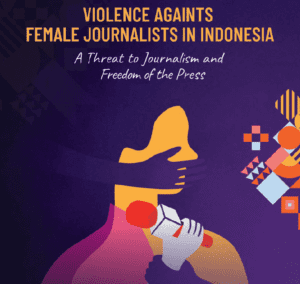Read the Report
Freedom of the press has been guaranteed by Article 28 of the 1945 State Constitution of the Republic of Indonesia and Law No. 40/1999 on the Press. However, violence against journalists, especially female journalists, continues to occur and is often minimally responded to by adequate legal and non-legal actions. Consequently, more significant efforts are necessary to address this issue.
This research was conducted through a survey (involving 1,256 respondents) and interviews (six informants) of female journalists in 191 cities, representing western, central, and eastern parts of Indonesia.
This survey included 25 questions about the respondents’ violence experiences related to their work in the digital and physical world. The forms of violence asked in the questionnaire cover all forms of violence that we could find in literature and case records in Indonesia and abroad, including various policies and practices of discrimination for female journalists in the workplace related to salaries, reporting assignments, and so on, which we included in the categories of violence in the physical domain.
From all the survey respondents, the researcher selected six respondents to be interviewed, based on the diversity of forms of violence, the context of the incidents, where they lived, and the form of media where they worked at. Furthermore, the findings of the survey and interviews were presented in discussions to various stakeholders to enrich the findings.
According to the statements from the female journalists, as many as 1,077 respondents (85.7%) had experienced violence during their journalistic career. Of these, as many as 70.1% of the respondents had experienced violence in the digital domain as well as in the physical domain, 7.9% of respondents had experienced Violence Against Female Journalists in Indonesia only violence in the digital domain (online), and 7.8% of respondents had experienced only violence in the physical domain (offline). Meanwhile, only 179 respondents (14.3%) never experienced any form of violence at all.
Of all forms of violence in the digital and physical domains investigated in the questionnaire, the form most commonly experienced by the respondents was offline body-shaming comments (59%), followed by online disturbing/harassing comments of a nonsexual nature (48%), online body-shaming comments (45%), offline threats or harassments of a sexual nature (40%), offline nonsexual threats or harassment (37%), online disturbing/harassing comments of a sexual nature (34%), gender discrimination at work (32%), online misinformation/defamation (28%), online abuses related to ethnicity/religion/race (22%), and physical assaults of a sexual nature (22%).
Based on the 272 received responses (aside from the respondents who chose not to respond), there were several ways in which respondents acted in response to cases of violence that they experienced. The way that most respondents (52%) chose to do was to report to their superiors or co-workers. Another common response was to report to the relevant organization such as journalist associations (29%) and file a lawsuit (10%). Other responses were to solve the problem independently, such as through personal confrontation, direct rebuke, discussions, counterattacks, recounting to relatives, and writing articles.
Of the 1,256 respondents, most of the suggestions related to the supporting tools and assistance that can prevent or overcome violence were training (40%), followed by guidelines or modules on preventing and overcoming violence (29%), legal aid or assistance (23%), and psychological assistance (7%).
In the interviews, all informants (six journalists) said that they had experienced sexual violence perpetrated by sources, both in the digital and physical domains. In the digital domain, informants experienced various forms of sexual violence, from seductive messages to photos of genitalia sent by their sources on WhatsApp. Sexual violence in the physical domain, for example, having their hair, shoulder, and cheek stroked, then hugged and their buttocks held, and their hand touched. Other examples were invitations to meet or interview at a hotel and proposals for marriage as a second or third wife.
For non-sexual violence, the informants said that this form of violence occurred mainly because of the reporting carried out by the informants, and their sources perpetrated the violence. This form of violence occurred in both physical and digital domains. For example, three informants had received death threats directly or via telephone and social media platforms.
Although the survey data do not show a strong relationship between the acts of violence and the topic of the journalists’ reporting, interviews show that female journalists are more vulnerable to violence when covering issues considered risky, such as gender and sexuality (LGBTIQ) and the environment. The latter finding is in line with the statement by the Committee to Protect Journalists, which classifies environmental investigations in developing countries as dangerous, second only to reporting of armed conflicts.

